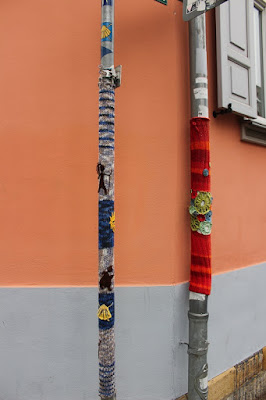Day
44
Neither
of us knew much about Erfurt so we spent a bit of time last night making a list
of stuff we wanted to see. Breakfast as
usual at a little bakery and then off on a route I’d planned out courtesy of
google maps.
Erfurt
is one of the most intact medieval cities in Germany having escaped any bombing
in WW2. Mentioned in the writings of St
Boniface in the 700’s, Erfurt grew to become an important trading city during
the middle ages and by 1275 it was a walled city with a town hall. It is part of the Via Regia, a medieval trade and
pilgrims' road network, which linked Rome with the Baltic Sea, and Moscow with Santiago
de Compostela in northern Spain. It's situated on the River Gera - which through the town itself is not exactly a 'river' ... more of a small stream.
The
current town hall in the Altstadt was built in 1870 and is surrounded by more
examples of gorgeous renaissance architecture.
 |
| The Erfurt Rathhaus (Town Hall) |
After
a wander round the Altstadt we headed for the Kramerbrucke. Built to cross the Gera River as a wooden bridge 1156,
damaged in a number of fires between then and 1472, and finally re-built in its
current form in 1486 it’s lined on both sides with wonderful merchants houses.
 |
| One of the merchant shops was a puppet makers workshop |
A
Jewish community was also founded in the 12th century but in 1349, the Jews of Erfurt
were rounded up, and driven from the city
because the local Christian population blamed them for contaminating the
towns water supply with the Plague.
We did a tour of the Old Synagogue. After the pogram of 1349 the building was
taken over by a wealthy merchant and turned into a warehouse. It was this which may have inadvertently
saved it from destruction as it was virtually unrecognisable as a synagogue during
the years before WW2 and thus it was not destroyed. You are not allowed to take photos inside so
here are just a couple of the outside.
It’s on the top floor however, that the most
incredible exhibition is to be found. In 1998 excavations were being carried
out for a new building on the Michaelisstrasse.
Under the wall of a cellar entry workmen discovered a hoard of
treasures, thought to have been buried sometime during the 1349 pogram. It consists of silver coins and ingots as well
as over 700 extraordinary works of gold smith work dating to the 13th and 14th
centuries. Among the treasures are 11
pieces of silver tableware including a Doppelkopf
( a common form of cup in the 14th and 15th century), a shallow drinking bowl,
a jug and 8 goblets that fit into each other. These goblets are decorated with
gothic arches that have been gold plated and date to the first half of the 14th
century. Inside the double cup was a stash of jewellery including 8 brooches of
various sizes set with ornamental stones and 8 rings.
This mindblowing Jewish Wedding Ring
is the priceless centrepiece of the collection – the only one of its kind in
the world. (I lifted these photos from the internet so you could see just how
amazing they were)
A
coffee stop at Domplatz (the big square in front of the cathedral) and we were
off up the stairs to visit St Marys Dom. Built on the site of many other Christian
buildings, (Saint Boniface’s church from 742 and a Romanesque basilica) its been a build upon
what was there before site. The foundations of the original church were used
for a Romanesque basilica in the mid 12th century and the mound was then
enlarged in the early 14th century to make room for St. Mary's cathedral. It’s huge and lovely and Martin Luther was
ordained in the cathedral on 3 April 1507.
 |
| Gorgeous stained glass windows and amazing Gothic choir stalls |
Right
next door is St Severus Church. In 836, the relics
of St. Severus of Ravenna were brought by the Archbishop of Mainz to Germany,
first to Mainz and later to Erfurt. The relics were housed in a monastery that
stood on the site of the present Severikirche.
Building
of the present church began in the 1270's and it was consecrated in 1308.
The famous sarcophagus to hold the relics of St Severus was installed around
1365. Apart from the tomb, the other show-stopper is the baptismal font
with its spectacular 15m high canopy which was added in 1467.
 |
| A seriously serious church organ |
 |
| and the fanciest baptismal font I have ever seen |
 |
| No crypt (much to Tony's dismay) - but the floor is covered in tombstones |
We wandered some more through the old town- just taking random streets left and right as they looked interesting - here are a few of the highlights - half timbered houses and, especially for Lauren - a pole with a scarf.
 |
| The building on the left is part of the University of Erfurt that dates to 1392 |
Last
stop was the now partially destroyed Barfusserkirche (Black Friars Church)
where Martin Luther preached during his ten years in Erfurt. It’s currently closed for some additional
remedial and stabilisation work but even looking through the gate or taking
pics from across the road it was lovely and in its day would have been beautiful.
A
late coffee and home to discover we share a common wall with a ‘performance
space’ – this afternoon and tonight’s performances are ‘Urban Jazz” and its
bloody awful!
Erfurt is fantastic and we're looking forward to exploring the Citadel tomorrow.





























No comments:
Post a Comment